The Puppis constellation is located in the southern sky and was originally part of the much larger constellation Argo Navis, along with constellations Vela and Carina, which was first catalogued by the Greek astronomer Ptolemy in the 2nd century. Argo Narvis represented the the ship on which Jason and the Argonauts sailed on their quest for the Golden Fleece. The name Vela means “the sails”, in Latin, while Carina means “the keel” and Puppis means “the stern”.
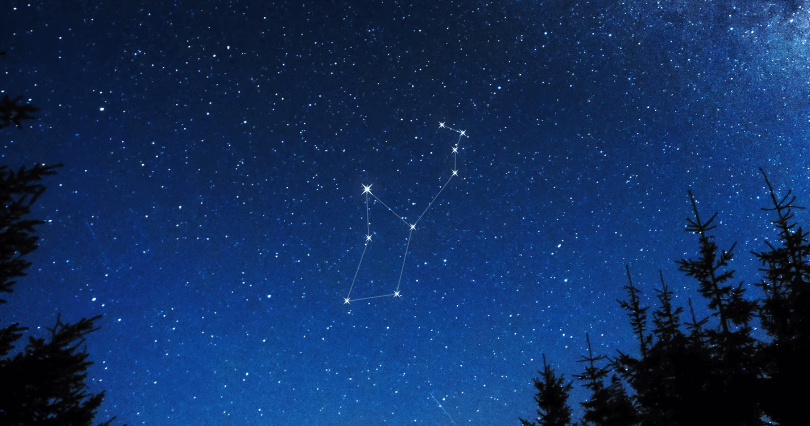
Puppis contains six stars with confirmed planets and five named stars. The star names, as approved by the International Astronomical Union (IAU), are Azmidi, Naos, Nosaxa, Tislit and Tureis. The brightest star in the constellation is Naos, with an apparent magnitude of 2.21.
It is also home to a number of deep sky objects, such as the Pi Puppis Cluster and the Skull and Crossbones Nebula. There are three Messier objects in Puppis — Messier 46, Messier 47 and Messier 93 — and there are three meteor showers associated with the constellation: the Pi Puppids, the Zeta Puppids and the Puppid-Velids.
History and Mythology Of The Puppis Constellation
Puppis used to be part of the constellation of Argo Navis, along with constellations Vela and Carina. Puppis itself isn’t associated with any myths. However, Argo Navis represented the ship on which Jason and the Argonauts sailed to Colchis to get the Golden Fleece.
The ship was named after its creator Argus, who built it under the orders of Athena, using timber from Mount Pelion. Argo Navis originally occupied a vast area of space between the constellations Canis Major and Crux. Due to the massive size of Argo Navis and the sheer number of stars that required separate designation, Nicolas Louis de Lacaille divided Argo into three sections in 1763, including Puppis.
Lacaille only used one set of Greek letters for all three constellations. This is why Puppis nor Vela have any stars designated Alpha or Beta. These designations belong to stars in the constellation of Carina.
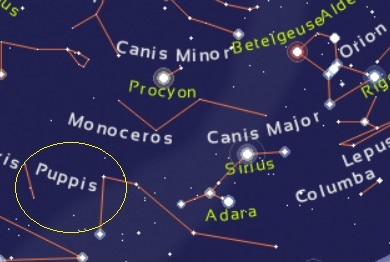
Location Of The Puppis Constellation
Puppis is the 20th largest constellation and occupies an area of 673 square degrees. It lies in the second quadrant of the southern hemisphere (SQ2) and can be seen at latitudes between +40° and -90°.
Its right ascension is 7.5h and its declination is −30°. It is best seen at 9pm during the month of February.
Puppis’ neighboring constellations are Carina, Canis Major, Columba, Hydra, Monoceros, Pictor, Pyxis and Vela and it belongs to the Heavenly Waters family of constellations, along with Carina, Columba, Delphinus, Equuleus, Eridanus, Piscis Austrinus, Pyxis and Vela.
Notable Stars
Naos
Naos, also known as Zeta Puppis, is the brightest star in the constellation and has an apparent magnitude of 2.21 — the 62nd brightest star in the sky. It is an exceptionally hot blue supergiant star, with the stellar classification O4If. It is one of the few O-class stars that can be seen without binoculars.
Naos is located around 1,090 light years away from us. It is 550,000 times more luminous than the Sun, a mass 22.5 times solar and a radius about 14 times solar. Its surface temperature is 42,000 K and it has a velocity of 2,500 km/s and, as a result, the star sheds over a millionth of its mass every year.
The name Naos means “ship”, which comes from the Greek ναύς.
Pi Puppis
Pi Puppis is the second brightest star in the constellation and has an apparent magnitude of 2.733. It is a double star that consists of an orange supergiant belonging to the stellar class K3 Ib and a companion with an apparent magnitude 6.86. The supergiant is a semi-regular variable star, and exhibits variations in brightness from magnitude 2.70 to 2.85, and has a radius about 290 times that of the Sun.
Pi Puppis is located around 810 light years away from Earth and it is the brightest member of the open cluster Collinder 135.
Tureis
Tureis, also known as Rho Puppis, is the third brightest star in the constellation and has a visual magnitude of 2.78. It is a yellow-white bright giant with the stellar classification F2mF5IIp and is also classified as a Delta Scuti type variable, with its brightness varying 0.15 over a period of 0.14088143 days.
Tureis is 22 times more luminous than the Sun and is believed to be about 2 billion years old. It has a mass 1.85 times that of the Sun and a radius 3.41 times that of the Sun. It is approximately 63.5 light years away from the Sun.
Azmidi
Azmidi, also known as Xi Puppis, is a yellow supergiant with the stellar classification of G6 Iab-Ib and an apparent magnitude of 3.35. It is located around 1,200 light years away from the Solar System and has a 13th magnitude companion.
Nu Puppis
Nu Puppis is a blue-white giant star with the stellar classification of B8III SB and a visual magnitude of 3.17. It is around 1,340 times more luminous than the Sun and is around 43 light years away from us.
Sigma Puppis
Sigma Puppis is a spectroscopic binary star system with the stellar classification of K5 III, matching the spectrum of an orange giant. It has an apparent magnitude of 3.25 and is classified as a Beta Lyrae type variable with a period of 130.5 days, which means it is a close binary system. Sigma Puppis is located around 194 light years away from the Sun.
Tau Puppis
Tau Puppis is a spectroscopic binary star system that is located around 182 light years away from Earth and has an apparent magnitude of 2.95. The primary component is an orange giant of the stellar type K1 III with a radius about 27 times that of the Sun. The two stars in the system orbit each other with a period of 1,066.0 days.
Omicron Puppis
Omicron Puppis is a multiple star system with the primary component a blue supergiant. The system has a visual magnitude of 4.40 and is located about 2,470 light years away from Earth.
NS Puppis
NS Puppis is an orange supergiant with the stellar classification K3Ib and an apparent magnitude of 4.44. It is around 1,874 light years away form Earth.
L2 Puppis
L2 Puppis is a red giant star that belongs to the stellar class M5IIIe and is located around 200 light years away from the Sun. It is also classified as a semi-regular pulsating variable and exhibits variations in brightness ranging from magnitude 2.60 to 6.00 with a period of 140.83 days. It has a visual 10th magnitude companion located an arc minute away.
V Puppis
V Puppis has a visual magnitude of 4.45 and is located around 1,165 light years away from us. It is a multiple star system, with a binary star at the center. This star is composed of a B1 class blue-white dwarf orbiting a blue-white class B3 subgiant star with a period of 1.45 days.
QW Puppis
QW Puppis has an apparent magnitude of 4.50 and the stellar classification F3VFe-1.0. It is located around 70 light years away from the Solar System and is classified as a Gamma Doradus type variable. This means that it is a young variable star that exhibits variations in luminosity as a result of non-radial pulsations of its surface.
NV Puppis
NV Puppis is a blue-white main sequence star with the stellar classification of B2V+ and an apparent magnitude of 4.65. It is classified as a Gamma Cassiopeiae variable and is located about 804 light years away from the Sun.
PU Puppis
PU Puppis, also known as 128 G. Puppis, is a binary star with the stellar classification of B8IV, meaning it is a blue-white subgiant star. It has an apparent magnitude of 4.69 and is located around 551 light years away from Earth. It is also classified as a Beta Lyrae variable.
MX Puppis
MX Puppis is a blue-white giant with the stellar classification of B1.5IIIe and an apparent magnitude of 4.81. It is a spectroscopic binary star with a period of 5.1526 days, and is also classified as a Gamma Cassiopeiae variable, or a shell star. This is a fast rotating star that has a circumstellar disc of gas at the equator and exhibits variations in luminosity as a result of the outflow of matter.
It is located around 979 light years away from the Sun. It has a mass that is 10 times that of the Sun and is 13,276 times more luminous than the Sun.
3 Puppis
3 Puppis is a binary star with a visual magnitude of 3.93, located around 2,280 light years away from the Sun. It has the stellar classification of A3Iab, matching the spectrum of a white supergiant. It is surrounded by circumstellar gas.
HD 60532
HD 60532 is a yellow-white star halfway between the main sequence and subgiant evolutionary stage and with an apparent magnitude of 4.450. It is located around 83.8 light years away from the Sun and is 8.596 times more luminous than the Sun. It has a mass that is 1.44 times that of the Sun and its radius is 2.52 times that of the Sun.
In September 2008, two planets were discovered orbiting the star with periods of 201.83 days and 607.06 days.
HD 63032
HD 63032, also known as c Puppis, is an orange giant with the stellar classification K4III and has a visual magnitude of 3.64. It is a member of the open cluster NGC 2451 and is around 1,085 light years away from Earth.
HD 64440
HD 64440 is a multiple star system with the stellar classification of K1.5II+. It has an apparent magnitude of 3.72 and is approximately 352 light years away from us.
HD 64760
HD 64760 is a blue supergiant with the stellar classification of B0.5Ib and an apparent magnitude of 4.23. It is located around 1,650 light years away from the Solar System.
HD 68601
HD 68601 is a white supergiant belonging to the spectral class A7Ib. It has an apparent magnitude of 4.76 and is located approximately 4,024 light years away from the Solar System.
HD 69830
HD 69830, also known as 285 G. Puppis, is an orange dwarf with the stellar classification of K0V and a visual magnitude of 5.95. It is located around 40.6 light years away from Earth and is about 7 billion years old. It has 45 percent of the Sun’s luminosity, a 86 percent of its mass and 89 percent of its radius.
In 2006, three extrasolar planets were confirmed to be orbiting the star after a debris disk was discovered orbiting the star in 2005. The planets’ masses are comparable to Neptune. The innermost planet has at least 10.48 times the Earth’s mass and an orbital period of 8.667 days. The middle planet has at least 12.07 times the Earth’s mass and a period of 31.56 days. The outermost planet has 18.43 Earth masses and a period of 197 days.
NGC 2423-3
NGC 2423-3 is a red giant star with the stellar classification of K-M III and an apparent magnitude of 9.45. It is a member of the NGC 2423 open cluster and is located around 2,498 light years away from Earth. It has a mass that is 2.4 times that of the Sun.
In July 2007, a planet, possibly a brown dwarf, with a mass at least 10.6 times that of Jupiter orbits the star every 714.3 days.
Deep Sky Objects
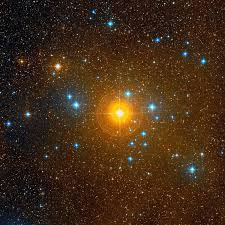
Pi Puppis Cluster
The Pi Puppis Cluster, also known as Collinder 135, is an open cluster that consists of four stars that are visible to the naked eye. The cluster has an apparent magnitude of 2.1 and is located approximately 840 light years away from us. The main star in the cluster, Pi Puppis, is a bright orange supergiant.
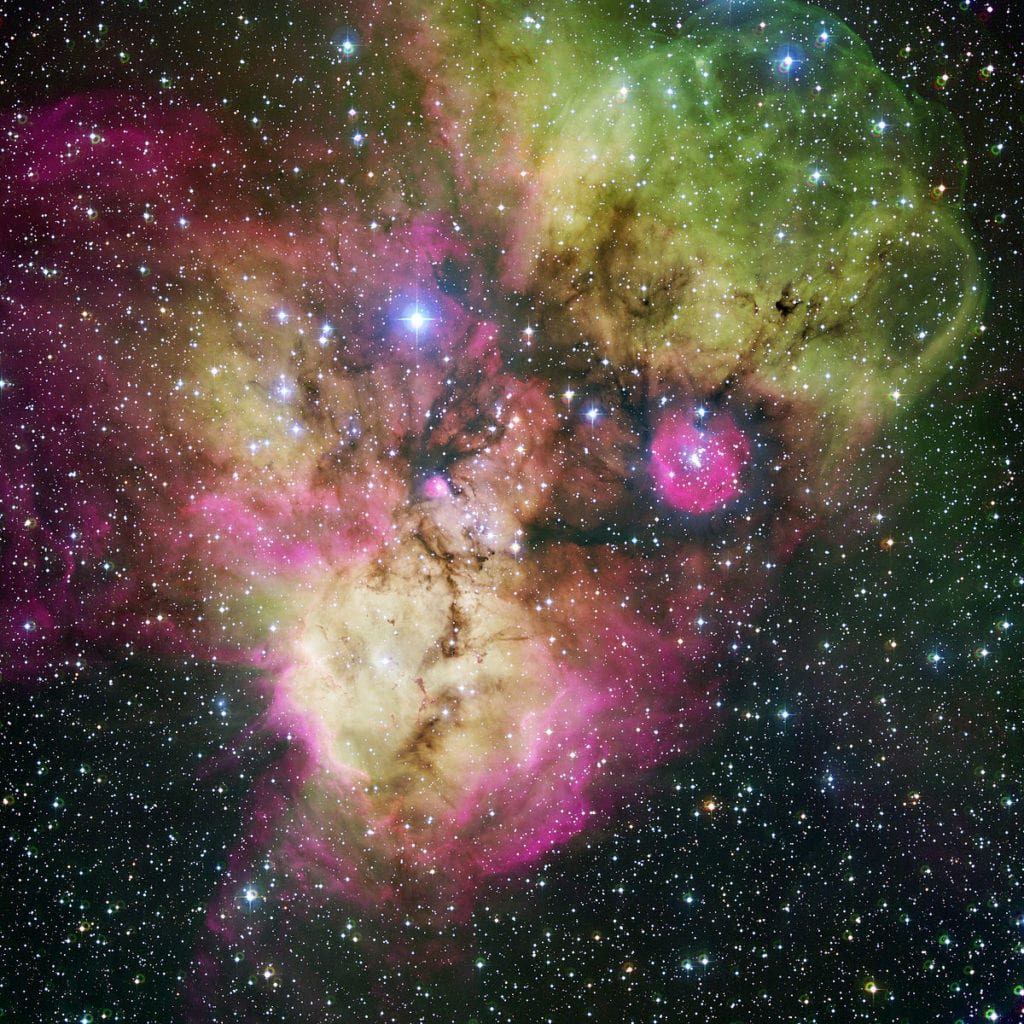
Skull and Crossbones Nebula
The Skull and Crossbones Nebula, also known as NGC 2467, is a star-forming region. The dominant star in the region is HD 64315, which is a massive young blue star belonging to the stellar class O6.
NGC 2467 is often thought to be an open cluster, but is not in itself a distinct open cluster. Instead, it consists of several groups of stars superimposed on one another along the same line of sight.
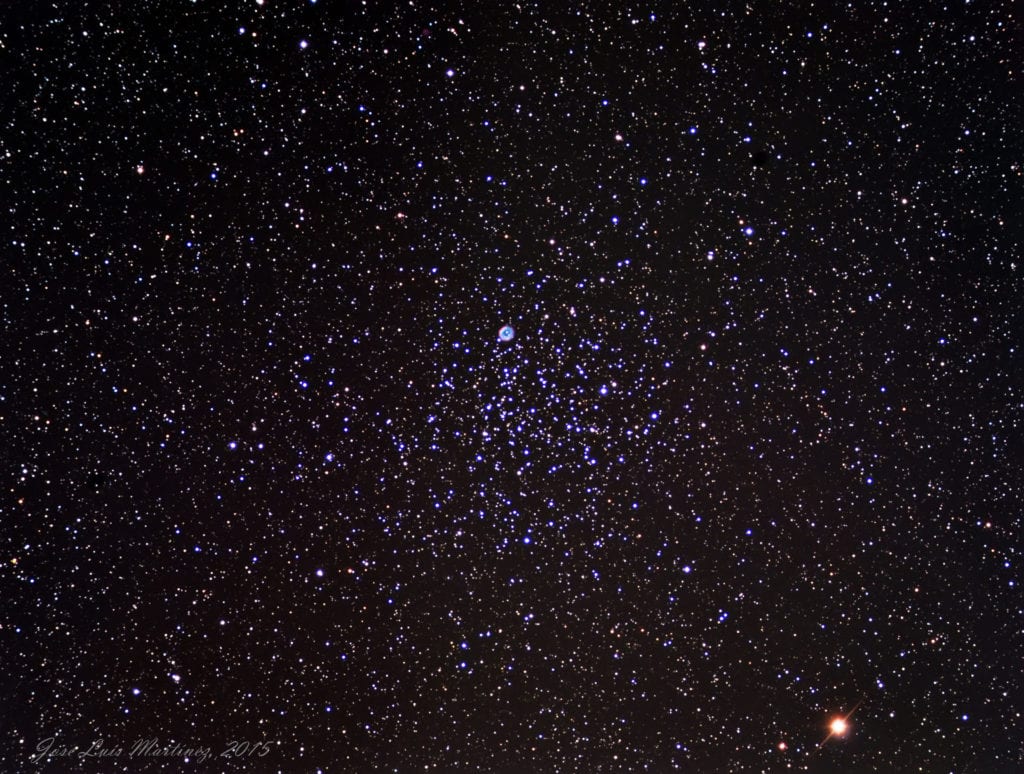
Messier 46
Messier 46, also known as M46 or NGC 2437, is an open cluster with an apparent magnitude of 6.1. It was discovered by Charles Messier in 1771 and is believed to be around 300 million years old. It is located approximately 5,500 light years away from Earth.
The cluster appears to contain the planetary nebula NGC 2438, but it is thought the two are probably not related and are just in the same line of sight.
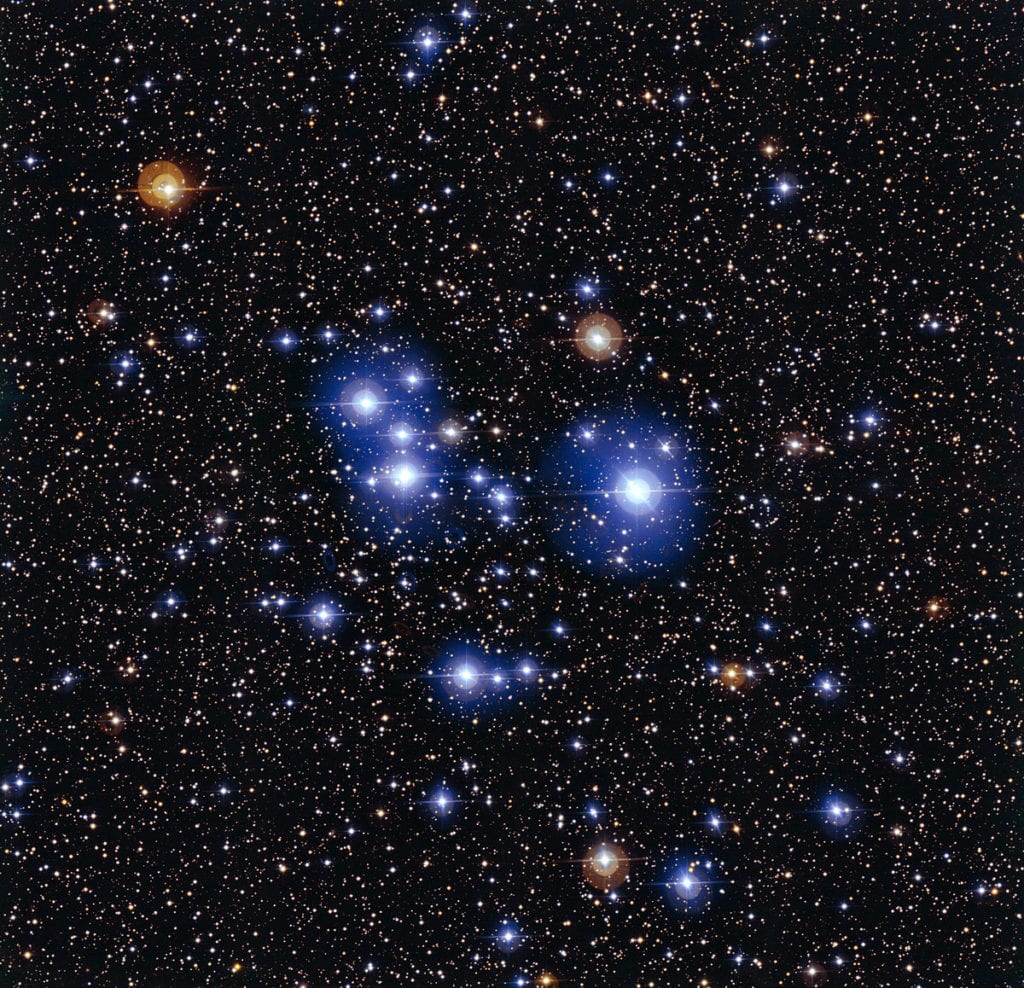
Messier 47
Messier 47, also known as M47 or NGC 2422, is an open cluster about a degree west of Messier 46, around 1,600 light years away from the Sun. It has an apparent magnitude of 4.2 and contains about 50 stars, the brightest of which is of magnitude 5.7.
M47 was discovered by the Italian astronomer Giovanni Batista Hodierna around 1654 and later independently discovered by Charles Messier on February 19, 1771. It is around 78 million years old.
Messier 93
Messier 93, also known as M93 or NGC 2447, is an open cluster with an apparent magnitude of 6.0. It was discovered by Charles Messier in 1782 and subsequently included in Messier’s catalogue. It is located around 3,600 light years away from Earth and is believed to be about 100 million years old. Messier 93 has a radius of around 10 light years.
NGC 2298
NGC 2298 is a globular cluster that was discovered by the Scottish astronomer James Dunlop on May 8, 1826. It has an apparent magnitude of 9.3 and is located around 30,000 light years away from the Solar System.
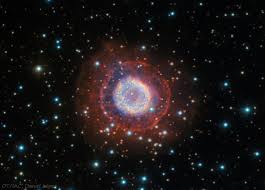
NGC 2438
NGC 2438 is a planetary nebula with a visual magnitude of 10.8 that was discovered by the German-born British astronomer William Herschel on March 19, 1786. It is located around 2,900 light years away from us and appears superimposed on the cluster Messier 46, but the two objects are most likely unrelated as they do not share a common radial velocity.
NGC 2438 has an extended halo and the central star is a white dwarf with a visual magnitude of 17.7. The dwarf is one of the hottest stars known, with a surface temperature of 74,700 degrees Celsius.
NGC 2439
NGC 2439 is an open cluster with an apparent magnitude of 6.9. It is located around 12,570 light years away from Earth and can be seen with a small telescope. It is thought to be around 10 million years old and is 10 arc seconds in size.
NGC 2440
NGC 2440 is a planetary nebula with an apparent magnitude of 9.4. It was discovered by William Herschel on March 4, 1790 and is located around 4,000 light years away from Earth. The central star, HD 62166, is possibly the hottest white dwarf known. It has a surface temperature of 200,000 kelvins and is 1,100 times more luminous than the Sun. It has an apparent magnitude of 17.5, a mass 0.6 times that of the Sun and a radius that is 0.028 times the radius of the Sun.
NGC 2451
NGC 2451 is an open cluster that was discovered by Giovanni Batista Hodierna in 1654. It is actually two clusters, named NGC 2451 A and NGC 2451 B.
NGC 2451 has a visual magnitude of 2.8 and contains about 40 stars, the brightest of which is c Puppis. The cluster is located around 850 light years away from us.
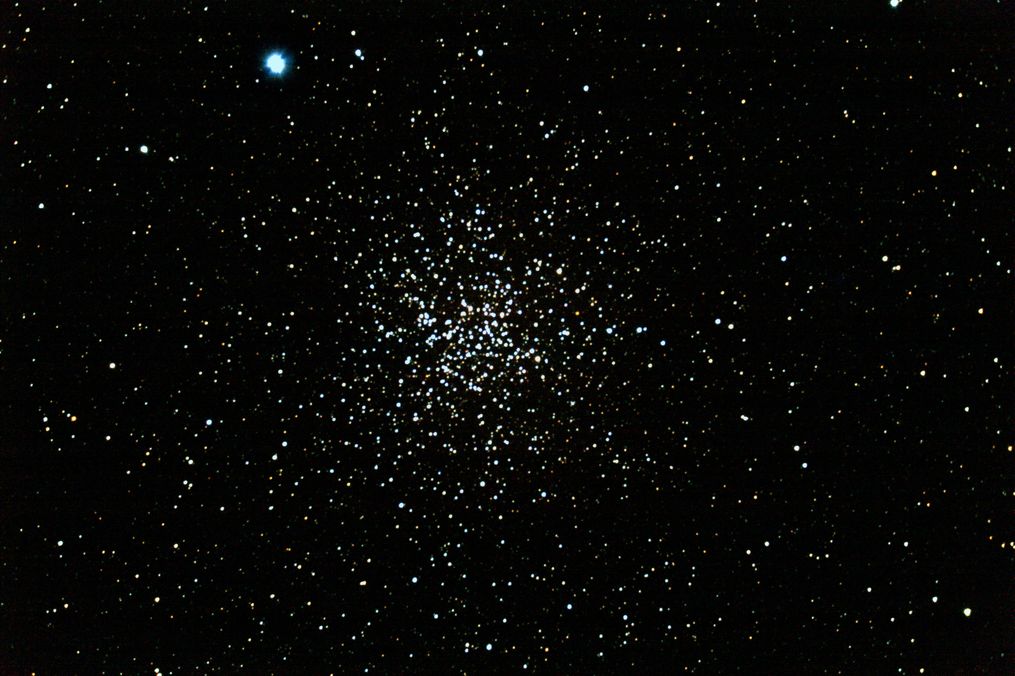
NGC 2477
NGC 2477, also known as Caldwell 71, is a cluster with an apparent magnitude of 5.8 that contains about 300 stars. It is located around 3,600 light years away from the Sun, near NGC 2451.
The cluster was discovered by Nicolas Louis de Lacaille in 1751 and it is thought to be about 700 million years old. It is often called “one of the top open clusters in the sky”.
NGC 2509
NGC 2509 is an open cluster with an apparent magnitude of 9.3. It was discovered by William Herschel in 1783.
NGC 2546
NGC 2546 is an open cluster that was discovered by Lacaille in 1751-1752. It has an apparent magnitude of 6.3 and is located around 3,300 light years away from us.
Images:
- Some Images created with the NightVision app – https://www.nvastro.com/nvj.html
- Some Images created with the Stelvision Sky Map https://www.stelvision.com/en/sky-map/
- Puppis 1 – https://starregistration.net/constellations/puppis-constellation.html
- Puppis 2 – https://en.wikipedia.org/wiki/Puppis
- Pi Puppis Cluster – https://www.constellation-guide.com/constellation-list/puppis-constellation/
- Puppis 3 – https://in-the-sky.org/data/constellation.php?id=69
- Skull and Crossbones Nebula – https://en.wikipedia.org/wiki/NGC_2467
- Messier 46 – https://en.wikipedia.org/wiki/Messier_46
- Messier 47 -https://en.wikipedia.org/wiki/Messier_47
- NGC 2438 -https://apod.nasa.gov/apod/ap110407.html
- NGC 2477 -https://en.wikipedia.org/wiki/NGC_2477